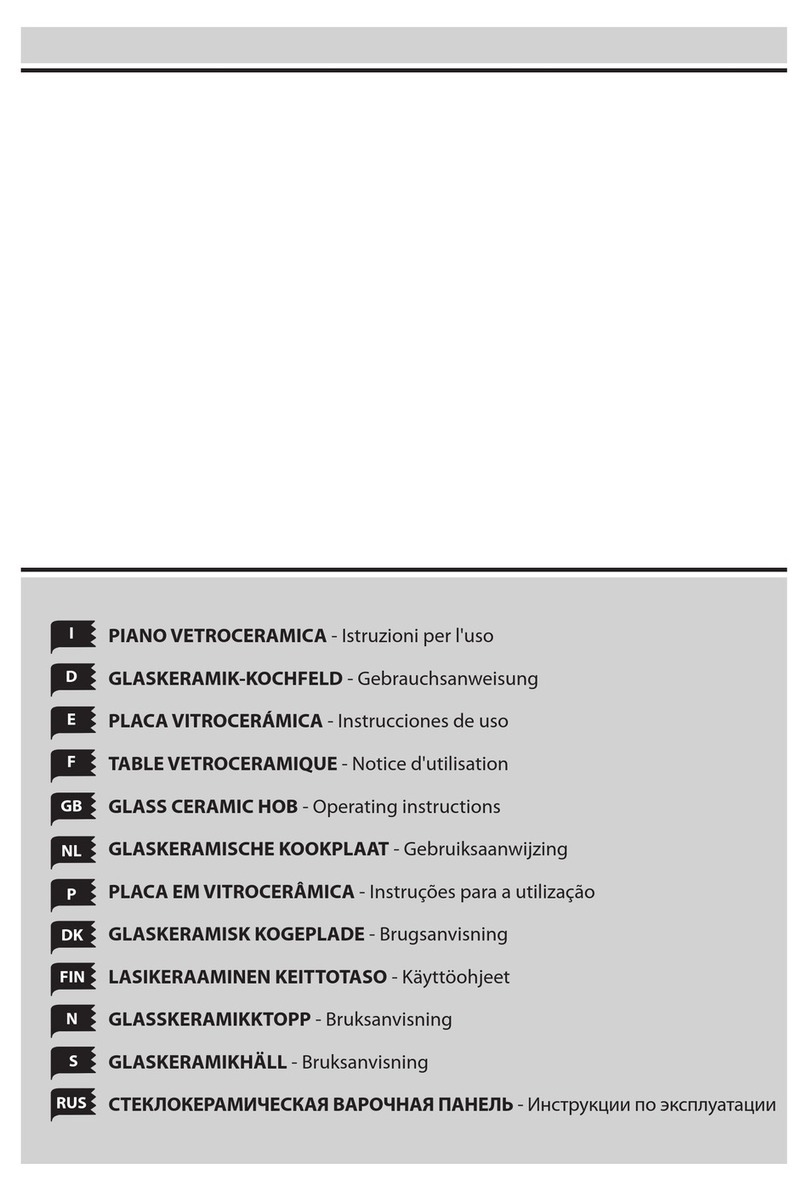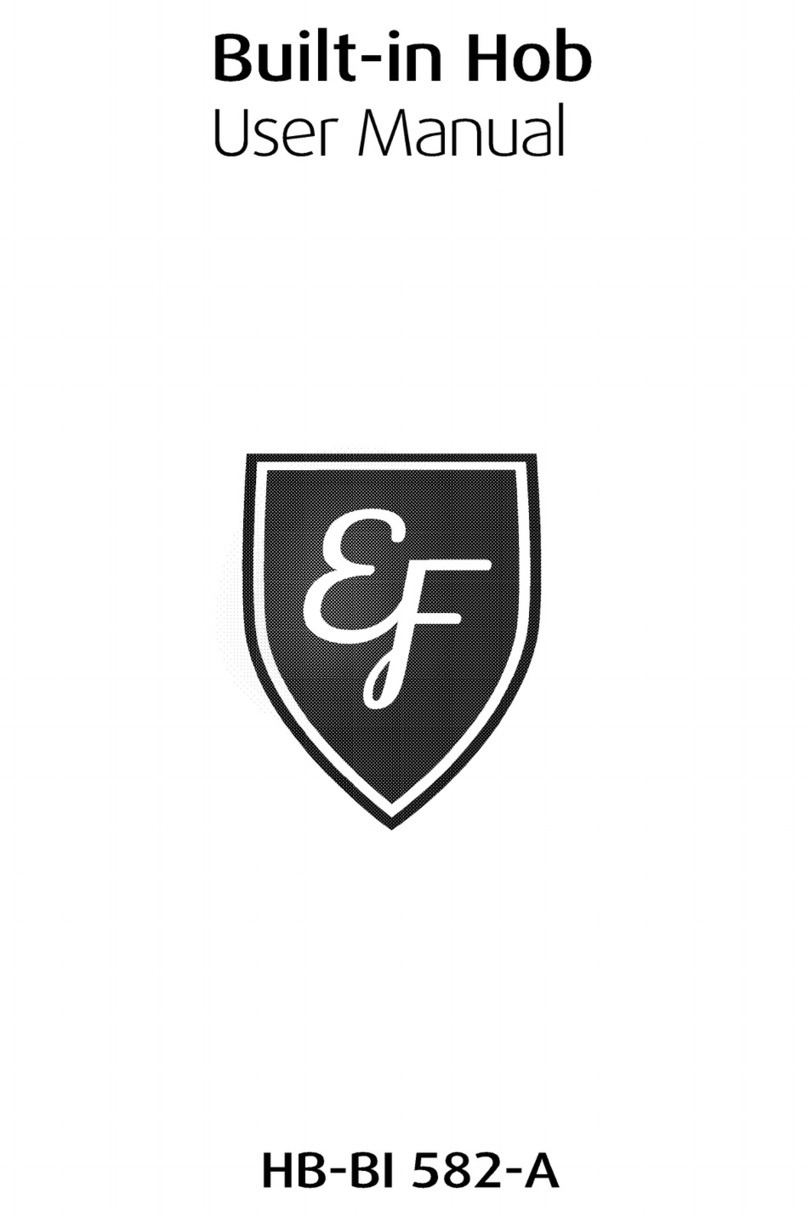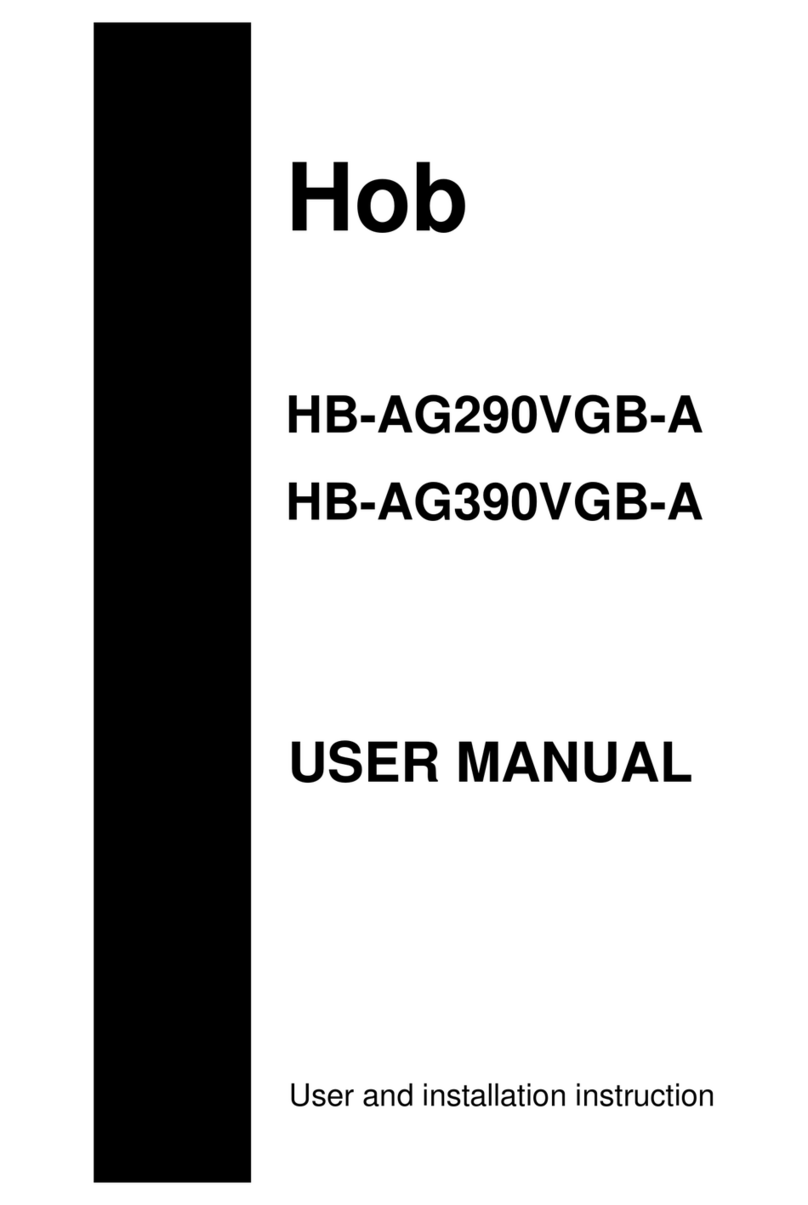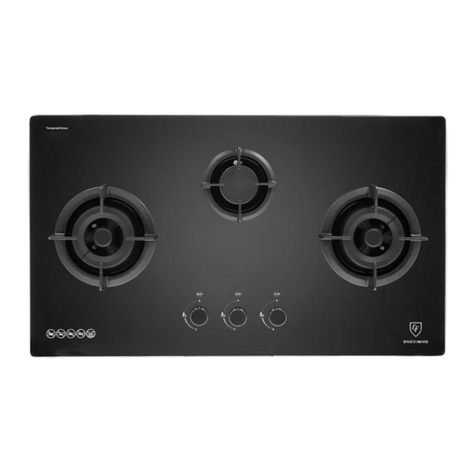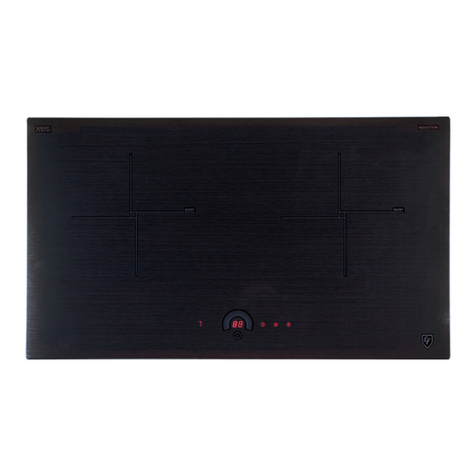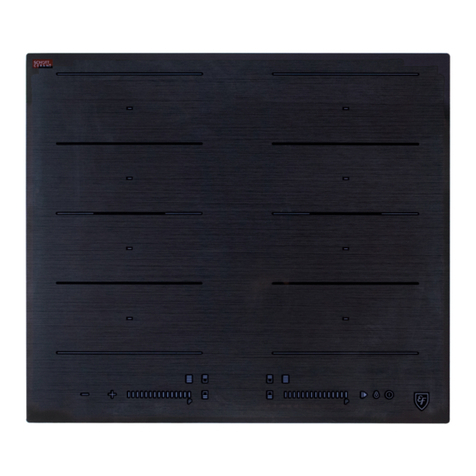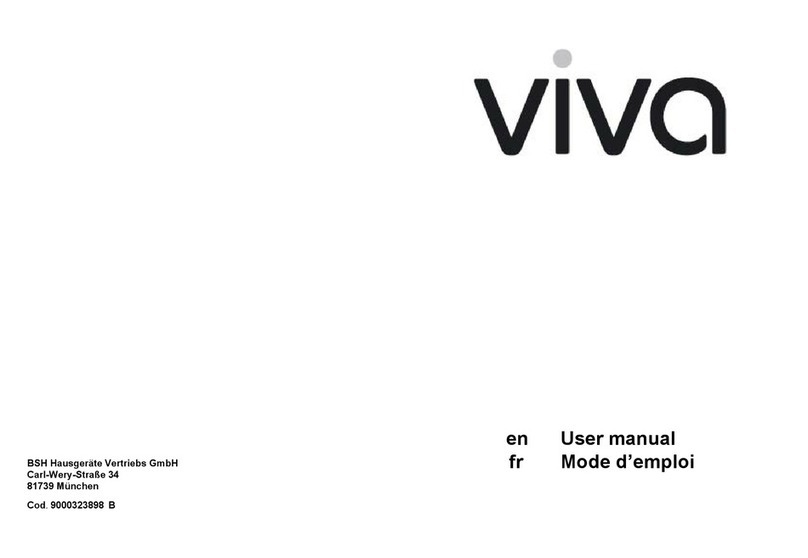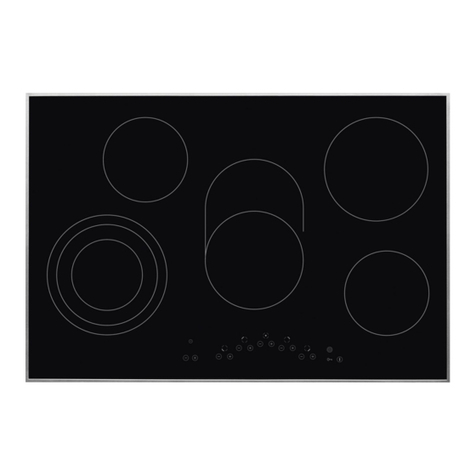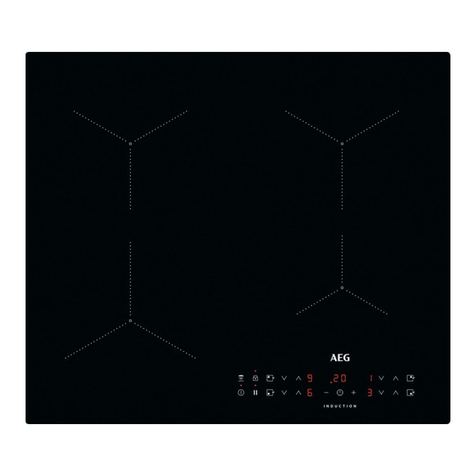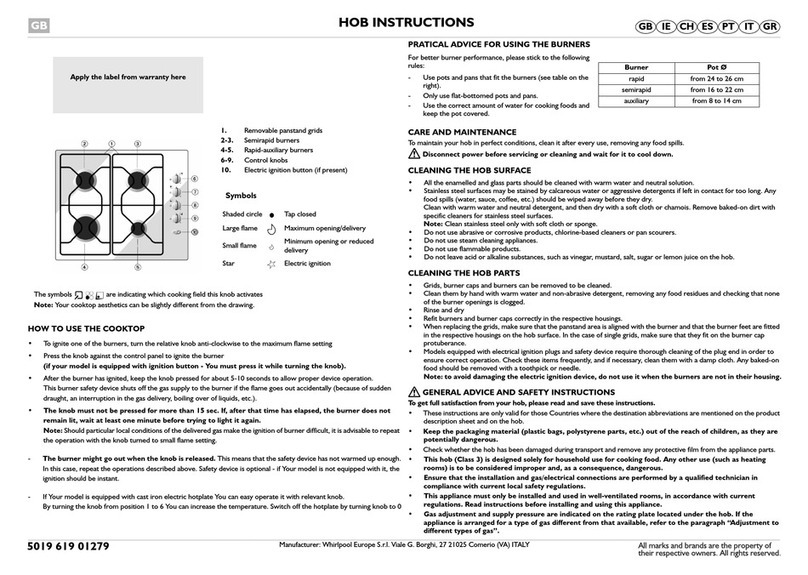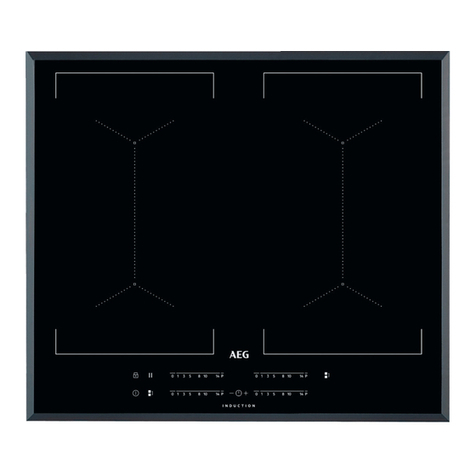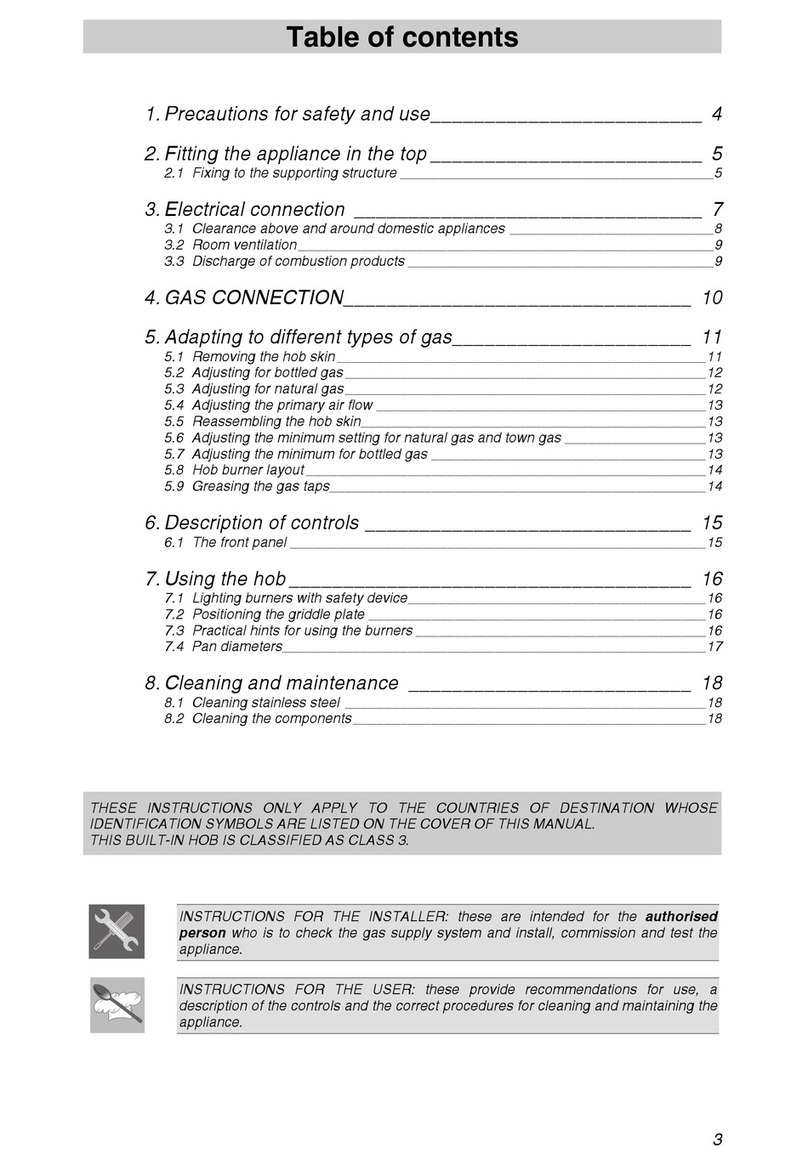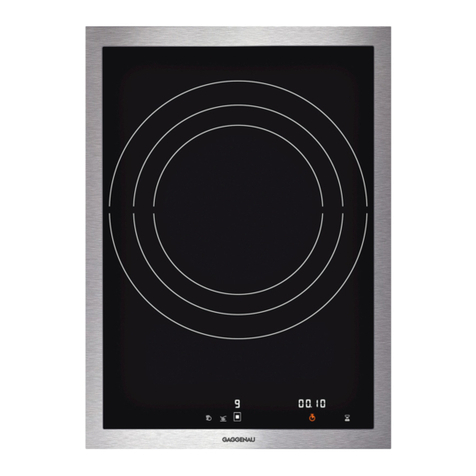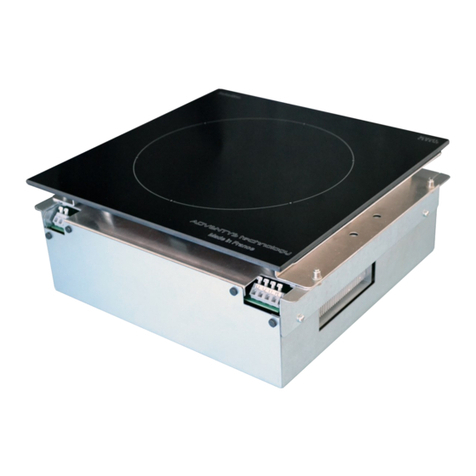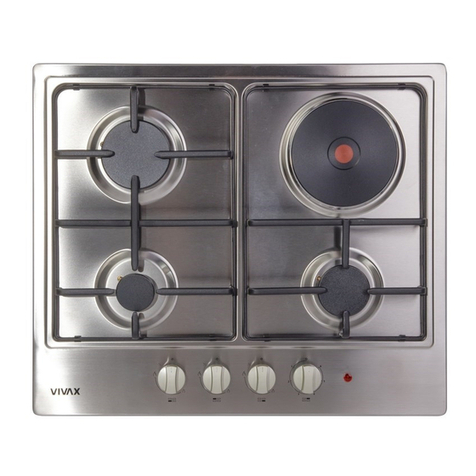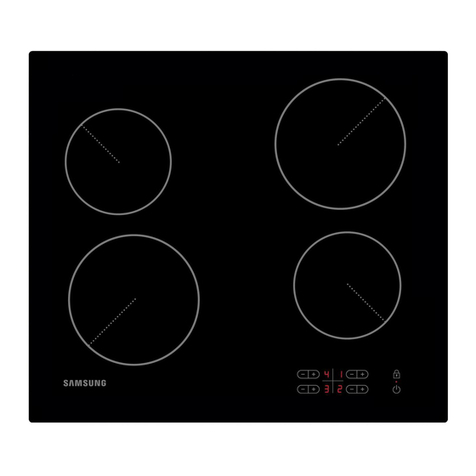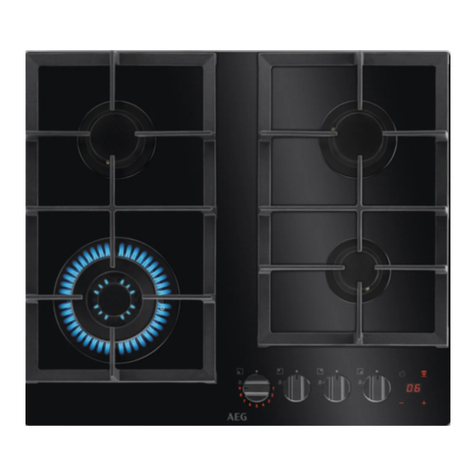EF HB AG 360 VS A User manual

pg. 1
Hob
USER MANUAL
HB AG 360 VS A
User and installation instruction

pg. 2
These instructions have been drawn up for your safety and that of others. You
are therefore requested to read them carefully before installing and using the
appliance. Keep this instruction manual for future reference as necessary. If the
appliance is sold or moved, make sure that this manual is handed over to the new
user.
Installation
·Installation of the appliance and its connection to the electrical mains must only be
carried out by QUALIFIED STAFF. Before any procedure, it is important to check
that the appliance is DISCONNECTED from the electrical mains.
·It is risky to modify or attempt to modify the characteristics of this product.
·After removing the appliance from the packaging, make sure that it is undamaged
and that the electrical lead is in perfect condition. Otherwise, contact your dealer
before putting the appliance into operation.
·The Manufacturer declines all responsibility in the case of failure to comply with the
accident prevention regulations.
·Make sure that air is able to circulate freely around the appliance. Poor ventilation
produced a shortage of oxygen
· Make sure that the appliance is supplied with the type of gas indicated on the
relative sticker next to the mains gas connection pipe.
· Use of a gas cooking appliance produces heat and moisture in the room in which it
is installed. Ensure that the room is well ventilated by keeping the air intakes open
and in good working order or by installing an extractor hood with discharge pipe.
· If the appliance is used intensively for a long time the effectiveness of the
ventilation will have to be increased, for example by opening a window or
increasing the power/speed of any electric extractor fan.
During use
·This product is designed to cook food in ordinary homes and for non-industrial
purposes. It should not be used for any other purpose.
·After using the appliance, make sure that all controls are in “CLOSED” or “OFF”
position.
·If you use an electrical socket close to this appliance, take care that the cables of the
appliances you are using do not touch it and are far enough away from the hot
parts of this appliance.

pg. 3
Children’s safety
·This appliance must only be used by adults. Make sure that children do not touch
the controls or play with the appliance.
·The exposed parts of this appliance heat up during cooking and remain hot for some
time even after it is switched off. Keep children well away until the appliance has
cooled down.
Cleaning and maintenance
·Keep the appliance thoroughly cleaned. Food residues may cause fire risks.
Service and parts
·In the instance of malfunctions, never attempt to repair the appliance yourself.
Repairs by unskilled persons may cause damage and accidents. First, refer to the
contents of this manual. If you do not find the necessary information, contact your
nearest Service Centre. Servicing work on this appliance must be carried out by an
authorized Technical Service Centre personnel. Always request the use of original
spare parts.
Environmental protection advice
·All the materials used are environmentally compatible and recyclable. Please make
your contribution to conserving the environment by using the separate waste
collection channels available.
Decommissioned appliances
·Appliances which are no longer used or useable are not worthless waste. Through
environment-friendly disposal, a number of materials used in the production of
your appliance can be recovered.
·Find out about the current disposal options from your specialist dealer or your
local authority.
·Before scrapping the appliances cut the power supply lead and make it unusable.

pg. 4
Contents
For the User
For your safety………………………………………………………………… 2
Description of the hob………………………………………………………… 5
Instructions for use …………………………………………………………… 5
Cleaning and maintenance……………………………………………………… 7
For The Installation Technician
Technical data………………………………………………………………… 9
Instructions for the installation technician…………………………………… 10
Electrical connection…………………………………………………………… 12
Adapting to the different types of gas………………………………………… 13
Building into fitted kitchen units……………………………………………… 14
Guide to reading the instructions
The following symbols will help you
When reading the instructions:
Safety information
“Step by step” instructions
Suggestions and Advice
Information concerning environmental protection
This appliance complies with the following EEC Directives:
-73/23 and 90/683 (relating to Low Voltage);
-89/336 (relating to Electromagnetic Compatibility);
-90/396 (relating to Gas Appliances);
-93/68 (relating to the General Standards )
And subsequent amendments.

pg. 5
Description of the hob
Instructions for use
The hob control knobs
The symbols on the control knobs mean the following:
●no gas flow
maximum gas flow
Minimum gas flow
All operating positions must be set between the
maximum and minimum flow settings, and never
between the maximum setting and the closed
position.
(Symbol present on a version with lighting A-Burner cap
integrated into the Control knob) B-Lighting plug
C-Thermocouple
D-Triple flame cap
Dual triple flame version
●no gas flow
maximum gas flow from the central burner
minimum gas flow from the central burner
maximum gas flow from outer and central burners simultaneously
minimum gas flow from outer and central burners simultaneously
1. semi-rapid burner
2. Triple ring burner
3.Burner control knobs
1
1
2
3

pg. 6
Lighting the burners
To obtain a flame more easily, light the burner before placing a cooking
utensil on the pan stand
To light a burner, proceed as follow: for Version with lighting integrated into
the
control knob push the knob of the burner fully down and turn it
anticlockwise
to the “maximum flow” setting symbol, or press the button if the appliance
has individual lighting.
●After lighting the flame, keep the knob pressed for about 10 seconds: this
time is necessary to heat up the “thermocouple”(Fig.1-C) and activate the safety
valve, which would otherwise cut off the gas flow.
Then check that the flame is even and turn the control knob to adjust the flame
as required
In the instance of a power cut, place a flame near the burner and proceed as
already described.
If the flame does not light after a few attempts, check that the “burner cap” and
“flame cap” are correctly positioned.
To turn off the flame, turn the control knob clockwise to the ●symbol.
Before removing pans from the burners, always lower or turn off the
flame.
For correct use of the hob
For lower gas consumption and better efficiency. Use only flat-bottomed pans of
dimensions suitable for the burners, as shown in the table below. Also, as soon as a
liquid comes to the boil take care to turn the flame down to a level that will just keep
it boiling.
Burner minimum diameter maximum diameter
Large(rapid) 180mm 220mm
Medium(semi-rapid) 120mm 200mm
Small(Auxiliary) 80mm 160mm
Triple Flame 220mm 260mm
During cooking processes involving fats or oils, watch your foods
carefully
because these substances may catch fire if brought to high temperatures.

pg. 7
Cleaning and maintenance
Before each operation, disconnect the appliance from the electrical mains and allow it
to cool down.
General cleaning
Wash enameled parts with lukewarm water and detergent: do not use abrasive
products which might damage them.
Wash the flame caps and burner caps often with boiling water and detergent, taking
care to remove all deposits
The hob pan stands can also be washed in a dishwasher
For stubborn dirt, use ordinary non-abrasive detergents or specific commercial
products. We strongly advise you not to use scouring pads. Steel wool or acids for
cleaning.
Hob
Clean the hob regularly with a soft cloth wet with lukewarm water and a little liquid
detergent. Do not use the following products:
- household detergents or bleaches;
- soaped scouring pads not suitable for non-stick utensils;
- steel wool scouring pads;
- stain removers for baths or sinks.
If the hob gets very dirty, use specific commercial products.
Ignition plug
Automatic burner ignition is provided (when installed) by a ceramic “plug” and a
metal electrode (B in fig.1). Periodically clean these parts of the hob thoroughly. In
addition, to avoid ignition difficulties, check that the cavities in the burner are not
obstructed.
To remove deposits from the burner cavities,
remove the cap and separate the two parts
(see diagram on the right). After cleaning,
put the two parts back together and return
them correctly to their position. After washing,
replace the hob pan stands, checking that they
are correctly positioned.

pg. 8
Routine maintenance
Have the condition and efficiency of the gas pipe and the pressure regulator(if
installed) checked periodically? If anomalies are found, do not repair but have the
faulty part replaced.
To ensure good performance and safety, the gas regulator taps must be greased
periodically.
Periodic lubrication of the taps must only be carried out by qualified staff,
who must also be contacted if the appliance malfunctions.
Service and parts
Before leaving the factory, this appliance was tested and adjusted by specialist skilled
staff to give the best operating results. Any subsequent necessary repairs or
adjustments must be carried out with the greatest care and attention.
For this reason, we strongly advise you always to contact the Dealer who sold you the
appliance or our nearest Service Centre, specifying the nature of the problem, the
model of the equipment(Mod.). the product number(Prod. No.) and the serial
number(Ser. No.). These data are provided in the plate on the cover of this manual.
Always request the use of original spare parts.
Warranty conditions
Your new appliance is covered by a warranty. The warranty conditions are provided
in full in the “Warranty conditions-Service Centres” leaflet which you will find inside
the appliance
Keep the purchase receipt or delivery note, either of which documents your purchase
of the appliance and provides proof of the date of purchase, in a safe place together
with the leaflet.
If the After-Sales Service is call in, show these documents to the staff. If this
procedure is not followed, the Service-Centre will have no option but to charge for
any repairs.
If necessary, you may find your nearest Centre by consulting the “Warranty
conditions –Service Centres”.

pg. 9
Technical Data
Nominal Heat Input obtained using G110 gas at 10 mbar
Position of
Burners
Type Of
Burners
Injector Ø
(mm)
Measured Heat
Input (kW)
Declared Heat
Input (kW)
Nominal Nominal
Back Right Semi Rapid 1.60 1.44 1.57
Left Triple Ring 3.10 3.42 3.50
Front Right Semi Rapid 1.60 1.44 1.57
Nominal Heat Input obtained using G30 gas at 29 mbar
Position of
Burners
Type Of
Burners
Injector Ø
(mm)
Measured Heat
Input (kW)
Declared Heat
Input (kW)
Nominal Nominal
Back Right Semi Rapid 0.65 1.72 1.75
Left Triple Ring 0.98 3.74 3.80
Front Right Semi Rapid 0.65 1.70 1.75
Gas intake connection G1/2″
Electricity supply AC 220-240v 50/60Hz
Battery supply DC 1.5v

pg. 10
Instructions for the installation technician
CAUTION: This appliance must only be installed and used in rooms with
permanent ventilation to local standards.
Installation of the appliance and its connection to the electrical mains must
only be carried out by QUALIFIED STAFF.
Before any procedure, it is important to check that the appliance is
DISCONNECTED from the electrical mains. The Manufacturer declines all
responsibility for any damage deriving from installation in breach of the
regulations in force or from failure to comply with the accident prevention
regulations.
Installation premises
For proper operation of a gas appliance, the air necessary
for the combustion of the gas must be able to flow into the
room naturally. The air must flow into the room directly
through openings in the outside walls. These openings must
have an unobstructed cross-section of no less than 2m3/hfor
each kW of power(see the total power in kW on the
appliance nameplate).
This opening must be constructed so that it will not be
obstructed from indoors or outdoor and placed close to the
floor, preferably on the side opposite to that on which the
flue gases are discharged. If it is not feasible to provide
these openings in the room where the appliance is installed.
The necessary air may be taken from an adjacent room,
provided that:
This room is not a bedroom or a hazardous
environment area;
This room is not in a vacuum;
The ventilation between the room where the
appliance is installed and the adjacent room is
guaranteed by permanent openings.
Discharge of flue gases
Gas cooking appliances must discharge their flue gases through hoods connected
directly to flues or the outdoors. If it is not possible to install the hood ( fig. B) an

pg. 11
electric fan must be installed on the outside wall or the window of the room, provided
it is possible for the ventilation opening
to be increased in proportion to the delivery rate of the fan (fig. C). For a kitchen, the
delivery rate of this electric fan must guarantee an hourly air exchange of 3-5 times
its volume. In both instances, the use of flues already used by other appliances to
discharge the flue gases is not recommended.
Connection to the gas supply
The gas Connection must be made in accordance with the
local standards. When installing fit a safety tap at the end
of the pipeline. The appliance leaves the factory tested and
set for the type of gas indicated on the plate inside the
bottom guard, close to the gas connection pipe. Make sure
that the type of gas to be supplied to the appliance is the
same as that shown on the plate. Otherwise, follow the
instructions provided in the “Adapting to different types of
gas” section.
For maximum efficiency and minimum consumption, make
sure that the gas supply pressure complies with the values
shown in the gas used is different from that specified( or
variable ).a suitable pressure regulator must be installed on
the supply pipeline.
The union must be fitted on the end of the gas train. Complete with GJ1/2"threaded
nut, fitting the gasket between the components as shown in the illustration. The
gaskets must comply with the local standards. Screw the parts together without
forcing, fit the union so that it points in the direction required then tighten all parts.
Connection
Make the connection to the gas system using a rigid metal pipe and regulation unions,
or with a stainless steel hose complying with the local standard. If metal hoses are
used, take care that they do not come into contact with mobile parts and are not
crushed. This must also be checked if the hob is to be combined with an oven.
The gas intake connection of the appliance has a “ male thread.”
When making the connection, take care not to apply stresses of any kind to the
appliance.

pg. 12
When the installation is complete, always check that all the unions are
absolutely tight using a soapy solution. Never use a flame to make this
check.
Electrical connection
The appliance is designed to operate with a power
supply voltage of 230Vsingle-phase. The connection
must be made in accordance with the regulations and
laws in force.
Before making the connection, make sure that:
1) the safety circuit-breaker and the electrical system
are able to withstand the load of the appliance(see
nameplate).
2) The power supply system has an earth connection
in good working order in accordance with the
regulations in force;
3) The socket or omni polar switch use are easily
accessible with the appliance installed.
Fit a plug suitable for the load on the power lead and
connect it to a suitable safety socket.
If you wish to make a direct connection to the mains.
an omni polar switch with a gap between the contacts of at least 3 mm, of suitable
rating for the load and complying with the regulations in force, must be installed
between the appliance and the mains. The switch must not break a contact in the
yellow/green earth wire.
The brown live wire (connected to the “L” terminal of the terminal board) must
always be connected to the live wire of the power supply mains.
In all cases, the power supply lead must be positioned so that it does not reach a
temperature 50oC above the room temperature in any point.
One example of an ideal route is shown in the illustration. The cable is guided by
means of band clamps fixed to the side of the cabinet, in order to avoid any contact
with the appliance underneath the hob.

pg. 13
Replacing the power supply lead
If the lead has to be replaced, only HO5RR-F or
HO5RN-F type cables suitable for the load and the
operating temperature must be used. In addition, the
yellow/green earth wire must be about 2 cm longer than
the live and neutral wires.
Adapting to the different types of gas
Changing the nozzles
1) Remove the pan standee.
2) Remove the burner caps and flame caps from the burners.
3) Use a size 7 socket wrench to unscrew and remove the
nozzles, replacing them with those corresponding to the
type of gas to be used (see the table ).
4) Reassemble the parts, reversing the operations described above.
5) Then replace the setting data (close to the mains gas connection)with the one for
the new type of gas If the pressure of the gas used is different from that
specified(or variable),a suitable piped gas pressure regulator complying with the
standard must be installed on the supply pipeline. A
Setting the minimum level
1) Light the burner as already described.
2) Turn the tap to the minimum flame position.
3) Remove the control knobs.
4) Use a thin straight screwdriver to turn the by-pass pin located
next to the tap rod (see fig. B ).For LPG, turn the by-pass pin
fully clockwise.
The result should be a small, homogeneous flame which is
uniform around the entire burner ring. For the dual Triple
Flame version see fig. A. by-pass 1 central burner, by-pass 2
both burners.
5) Finally, check that the burner does not go out when the tap is
turned quickly from the maximum to the minimum position.
B

pg. 14
Building into fitted kitchen units
These hobs are designed for installation in fitted kitchen units up to 600mm deep with
suitable characteristics.
Any cabinet side panels taller than the height of the hob itself must be at least 150mm
away from the opening into which the hob is inserted.
The dimensions of the hob and the installation opening are shown in the illustration.
Insertion and fixing
Before inserting the hob in the installation
opening. Place the special gasket around the
bottom edge of the hob.
It is important to fix this gasket evenly,
without gaps or overlapping, to prevent liquid
from seeping under-neath the hob.
1) Remove the pan stands and the burner
caps and turn the hob upside down, taking
care not to damage the ignition plugs and
the thermocouples.
2) Place the gasket around the bottom edge
of the hob as shown in the illustration on
the right.
3) Place the hob in the installation opening
and push it down so that the hob is resting
firmly on the cabinet, as show in the
illustration. The side springs will hold it in
place.

pg. 15
Installation options
On base cabinet with door
When constructing the cabinet, suitable precautions must be take
to prevent contact with the casing of the hob, which becomes
very hot during operation. The recommended method for
overcoming this problem is illustrated in fig.1
The panel underneath the hob must be easily removable to allow
the hob to be locked in position and released in case of servicing
work
On base cabinet with oven
The installation compartment
must have the dimensions
shown in figures 2 and 3 and
must have supports to allow
satisfactory ventilation. Two
possible methods for avoiding
overheating are illustrated in
figures 3 and 4. The electrical
connections of the hob and
oven must be made separately
both for electrical reasons and
to simplify removal of the oven
through the front of the
cabinet.
Wall cabinets or extractor
hoods must be at least 650 mm
above the hob.
Table of contents
Other EF Hob manuals
